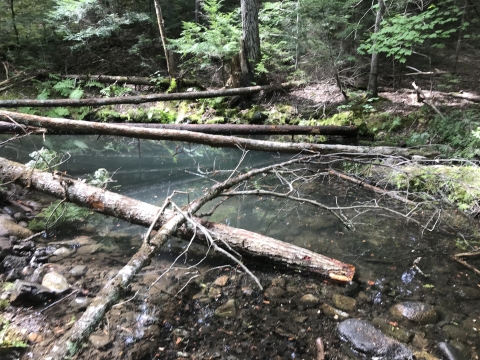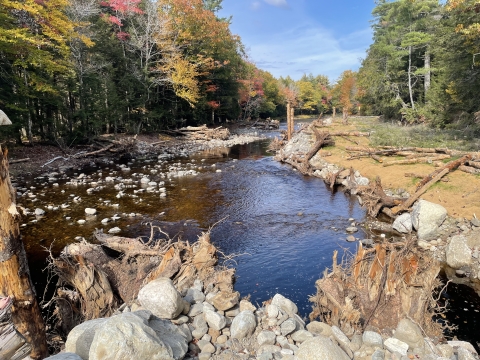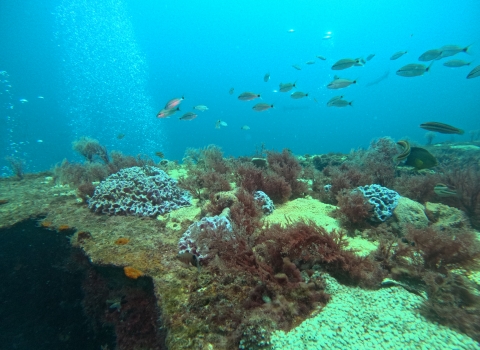The Gulf of Maine Coastal Program’s dedicated staff collaborate with numerous partners to achieve meaningful conservation that is important to fish, wildlife, and people in the Gulf of Maine watershed. We want to highlight a few of the projects and successes that made 2023 a great year.
Habitat Protection in the Gulf of Maine Watershed
The Gulf of Maine Coastal Program (GOMCP) staff and our federal, state, and NGO conservation partners have a shared interest in protecting crucial habitat for fish and wildlife in the Gulf of Maine watershed. To progress these conservation efforts, we provide technical assistance to partners aimed to help permanently protect high value habitat for fish and wildlife resources. This technical assistance is delivered in the form of extensive geographic information system (GIS) services, including habitat mapping and analysis using data collected from federal, state, and other sources.
In 2023, we worked with partners on three North American Wetlands Conservation Act (NAWCA) grants and one National Coastal Wetlands Conservation Grant (NCWCG) with a total of $6.3 million awarded ($9.5 million provided in match) to further conservation efforts in the Gulf of Maine watershed. Partners involved in these projects include Coastal Rivers Conservation Trust, Downeast Lakes Land Trust, Forest Society of Maine, Frenchman Bay Conservancy, Maine Coast Heritage Trust, Meddybemps Lake Land Trust, Maine Bureau of Parks and Land, and Midcoast Conservancy.
These four projects will conserve a total of 14,017 acres, which includes 3,650 wetland acres and 10,367 upland acres, ensuring the protection of palustrine emergent marsh, palustrine shrubs, palustrine forests, salt marsh salt marsh
Salt marshes are found in tidal areas near the coast, where freshwater mixes with saltwater.
Learn more about salt marsh , estuarine intertidal mudflats, riparian riparian
Definition of riparian habitat or riparian areas.
Learn more about riparian areas, and associated upland buffers. These projects will protect habitats that support the American Black Duck (a USFWS Atlantic Coast Joint Venture flagship species), 14 additional waterfowl species (including 4 NAWCA High Priority & 5 NAWCA Priority Species), 11 NAWCA Priority non-waterfowl species, 11 federally endangered (e.g., Atlantic salmon, red knot, piping plover), threatened (e.g., piping plover) or candidate species (e.g., wood turtle, monarch butterfly) and more than 18 state endangered (e.g., least tern), threatened (e.g., upland sandpiper, spotted turtle) or Special Concern Species (e.g., Nelson’s sparrow, whip-poor-will).
Narraguagus River Restoration at Route 9
The Narraguagus River Route 9 habitat restoration project in Beddington, ME was implemented to restore ecological processes and enhance habitat suitability for the federally endangered Atlantic salmon and other native aquatic organisms. The legacy effects of straightening the channel and removing large wood and boulders had impaired the river’s ecological processes that made it a complex and dynamic system.
This restoration project was the first of its kind in Maine and involved the construction of 3 engineered log jams, construction of a new floodplain to narrow the river, placement of large wood and boulders in the river, and reconnection of 2 historic side channels with substantial groundwater input from an adjacent esker. These actions were undertaken to restore natural processes to the reach, which had been lost by historic log drives that made the river over-widened, shallow, simplified, and unable to reconnect with its floodplain. Restoring the river to its natural morphology will improve hyporheic and groundwater exchange, improve shading, and create a diversity of complex habitats, which will convert this reach to climate-change refuge for Atlantic salmon, wild brook trout, sea lamprey, and many of the other native species living within the riparian corridor.
The project was completed in phases over several years, restoring a total of 13.5 acres of stream and floodplain habitat. The numerous project partners include Project SHARE, University of Maine, U.S. Forest Service, Maine Department of Marine Resources, NOAA Office of Habitat Conservation, Maine Audubon, and substantial donations from private industry. In addition to GOMCP and Maine Field Office (MEFO) staff working on the project, USFWS staff from the Maine Fish and Wildlife Conservation Office, Craig Brook National Fish Hatchery, Green Lake National Fish Hatchery, and heavy equipment operators from Moosehorn National Wildlife Refuge and Green Lake National Fish Hatchery provided invaluable contributions to the project.
CoastWise Approach – Tidal Restriction Replacement Guidelines for the State of Maine
The Maine Department of Marine Resources' Coastal Program and the CoastWise Steering Committee published a technical manual titled “Coastwise Approach: Achieving Ecological Resilience and Climate Ready Road Crossings in Tidal Environments.” The manual and associated CoastWise website provides science-based best-practices to municipal and private engineers, public works directors, and habitat restoration practitioners on how to replace tidal road culverts and bridges with safe, climate resilient crossings that restore tidal habitats. Ninety percent of bridges and culverts on Maine roads that cross salt marshes and tidal waterways are not equipped to handle the ebb and flow of the tides. This results in higher road maintenance costs, a shortened lifespan for crossings, unplanned road closures, and harm to commercial fisheries and important fish and wildlife habitat.
GOMCP staff played a significant role in developing the CoastWise Approach by serving on the Steering Committee and as a co-author on the manual. Over 30 organizations contributed to the development of the document over multiple years through many workshops and peer review. GOMCP continues to work with its partners in the development of user-friendly training materials and workshops to be delivered to the public in 2024.
Partners involved in this project include the Maine Coastal Program, NOAA Restoration Center and NMFS, Maine Coast Heritage Trust, The Nature Conservancy, Casco Bay Estuary, Partnership, Wells Estuarine Research Reserve, USFWS Rachel Carson National Wildlife Refuge, Kennebec Estuary Land Trust, Maine Department of Marine Resources, Corps of Engineers, Bates College, and the Town of York.
The Gulf of Maine Coastal Program is grateful for all of our staff and partners who helped us achieve our agency mission and ensured these collaborative successes in 2023. We look forward to continuing our support of Gulf of Maine partners and communities in 2024 to conserve habitats that are important to them.











